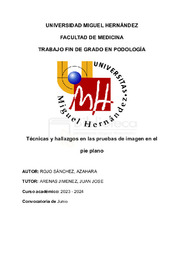Please use this identifier to cite or link to this item:
https://hdl.handle.net/11000/33399Full metadata record
| DC Field | Value | Language |
|---|---|---|
| dc.contributor.advisor | Arenas Jiménez, Juan José | - |
| dc.contributor.author | Rojo Sánchez, Azahara | - |
| dc.contributor.other | Departamentos de la UMH::Patología y Cirugía | es_ES |
| dc.date.accessioned | 2024-10-04T07:28:27Z | - |
| dc.date.available | 2024-10-04T07:28:27Z | - |
| dc.date.created | 2024-06-01 | - |
| dc.identifier.uri | https://hdl.handle.net/11000/33399 | - |
| dc.description.abstract | Introducción: La tomografía computarizada ha sido fundamental para reconstruir segmentos anatómicos en tres dimensiones, pero su limitación en la captura de imágenes en descarga dificultaba el diagnóstico de pie plano. La tomografía computarizada de haz cónico realizada en carga (TCEC) combina los beneficios de técnicas anteriores en una sola, ofreciendo alta resolución, menor exposición a la radiación y menor costo. Hipótesis: Las mediciones de pie plano con TCEC demuestran mayor fiabilidad que las radiografías. Objetivo: Identificar qué medidas en TCEC presentan mayor evidencia científica para el diagnóstico de pie plano. Metodología: Se establecieron criterios de inclusión para revisar estudios en TCEC, excluyendo pacientes con cirugía previa, menores de edad y estudios mayores a 5 años. La búsqueda se realizó en ScienceDirect y PubMed. Resultados: Se encontraron mediciones fiables, como el Ángulo de Alineación del Retropié Clínico (TCEC CHAA), el Ángulo del Eje Tibial (TACTA) y el Ángulo del Eje Tibial (TASJA), que han demostrado alta correlación y fiabilidad. Las mediciones tridimensionales del área de cobertura articular en las articulaciones del pie, muestran resultados consistentes y eficaces, con reducciones significativas en cobertura articular observadas en varias condiciones. Además, mediciones como la no cobertura de la faceta media de la articulación subastragalina (MF%) y el desplazamiento del pie y tobillo (FAO) destacan por su alta sensibilidad en la detección de deformidades, mientras que el ángulo de cobertura talonavicular (TNCA) muestra una alta especificidad. Conclusión: Aunque las medidas varían entre los diferentes estudios, la TCEC permite obtener medidas fiables para la evaluación del pie plano. | es_ES |
| dc.description.abstract | Introduction: Computed tomography has been pivotal in reconstructing anatomical segments in three dimensions, but its limitation in capturing weight-bearing images hindered flatfoot diagnosis. Cone beam computed tomography combines the benefits of previous techniques into one, offering high resolution, reduced radiation exposure, and lower cost. Hypothesis: Flatfoot measurements with WBCT demonstrate higher reliability than radiographs. Objective: To identify which WBCT measurements present stronger scientific evidence for flatfoot diagnosis. Methodology: Inclusion criteria were established to review WBCT studies, excluding patients with prior surgery, minors, and studies over 5 years old. The search was conducted on ScienceDirect and PubMed. Results: Reliable measurements were found, such as the Weight-Bearing Computed Tomography Clinical Hindfoot Alignment Angle (WBCT CHAA), Tibial Axis-Calcaneal Tuberosity Angle (TACTA), and Tibial Axis-Subtalar Joint Angle (TASJA), which have shown high correlation and reliability. Three-dimensional measurements of joint coverage area in foot joints show consistent and effective results, with significant reductions in joint coverage observed in various conditions. Additionally, measurements such as the Middle Facet Uncoverage Percentage (MF%) and Foot and Ankle Displacement (FAO) stand out for their high sensitivity in detecting deformities, while the Talonavicular Coverage Angle (TNCA) exhibits high specificity. Conclusion: Conclusion: Although the measurements vary between different studies, the WBCT allows for obtaining reliable measurements for the assessment of flat feet. | es_ES |
| dc.format | application/pdf | es_ES |
| dc.format.extent | 32 | es_ES |
| dc.language.iso | spa | es_ES |
| dc.publisher | Universidad Miguel Hernández | es_ES |
| dc.rights | info:eu-repo/semantics/openAccess | es_ES |
| dc.rights | Attribution-NonCommercial-NoDerivatives 4.0 Internacional | * |
| dc.rights.uri | http://creativecommons.org/licenses/by-nc-nd/4.0/ | * |
| dc.subject | Tomografía computarizada de haz cónico en carga (WBCT) | es_ES |
| dc.subject | Pie plano | es_ES |
| dc.subject | Radiodiagnóstico | es_ES |
| dc.subject | Evaluación clínica | es_ES |
| dc.subject.other | CDU::6 - Ciencias aplicadas | es_ES |
| dc.title | Técnicas y hallazgos en las pruebas de imagen en el pie plano | es_ES |
| dc.type | info:eu-repo/semantics/bachelorThesis | es_ES |

View/Open:
1735_Rojo_Sanchez_Azahara.pdf
538,27 kB
Adobe PDF
Share:
.png)
